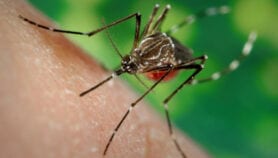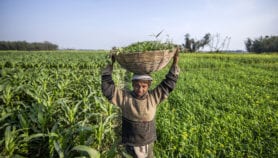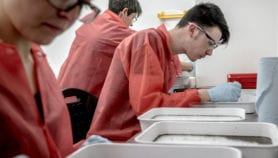Send to a friend
The details you provide on this page will not be used to send unsolicited email, and will not be sold to a 3rd party. See privacy policy.
The role of the public sector is often forgotten in disputes between critics of GM crops and the corporate sponsors of biotechnology. Joel I Cohen and Per Pinstrup-Andersen argue that this needs to be reversed.
Joel I Cohen is project manager of New Technologies at the International Service for National Agricultural Research (ISNAR), and Per Pinstrup-Andersen is director-general of the International Food Policy Research Institute (IFPRI).
Even though biotechnology and genetically modified (GM) crops are not formally on the agenda of the World Summit on Sustainable Development (WSSD), the stage is set for confrontation. Once again, corporate and governmental supporters of GM seed and their derived food products find themselves pitted against the needs of local, traditional farming systems, as well as developing countries that do not rely on GM technologies, and whose advocates wish things to remain this way.
Unfortunately, positions on both sides tend to be portrayed in an antagonistic manner, leaving little room for constructive discussion. As a result, little opportunity exists for efforts to achieve a balance between factors such as the different needs of the public and private sectors, the complex requirements of farming systems (both local/traditional and large-scale/commercial), and the continuous pressure to achieve food security in developing countries. Rather, a confrontational debate is sustained by the way in which both forms of farming are portrayed.
Local communities are often beyond the reach of markets. They tend to farm in traditional, self-contained systems that often lack improved seeds and other inputs. In such cases, farmers can remain self-sufficient in seed, and thus have few concerns about using inputs that have either biological or intellectual property (IP) restrictions on the technology.
Nor are farmers who pursue traditional farming practices and using local seed exposed to issues such as biosafety, restrictions on saved seed, and uncertain pricing/licensing policies. They are also able to confront unanticipated biotic challenges by preserving biodiversity in situ.
In contrast, the products of corporate or commercial providers are usually based on increased herbicide or insect resistance, aimed primarily at the needs of developed countries, and have some form of technology or licensing agreement.
Some GM crops, such as cotton, are available commercially to smallholder farmers in selected developing countries. However in general, commercial GM products have had little opportunity to demonstrate their relevance to increasing crop productivity in developing countries.
Private-sector research in developing countries could produce biotechnology inputs relevant to small-scale farmers. However, such opportunities are likely to remain limited, even in the larger middle-income countries. And in the poorest developing countries — including most African countries — such private research is almost non-existent.
A role for ‘public good’ research
Increasing opportunities for the small farmers requires emphasising the ‘public good’ nature of biotechnology. Debating the issues in terms of extremes, as above, ignores the fact that it is public research that can address needs in local areas — using GM or other modern technologies where appropriate. Furthermore, such research can make the products of these technologies available to farmers without conditions imposed by corporate suppliers.
Even in developing countries, the private sector will still have a role to play for local farmers who can afford the costs of improved seed. However, the ‘public goods’ nature of the technology required by most small farmers in developing countries provides little attraction for private investment. Neither does a lack of infrastructure, a lack of access to credit, and poorly functioning markets for seed, fertilizers and agricultural outputs.
Improving understanding between private and public sectors, as well as the stakeholders in both camps, will increase our ability to address food and agricultural needs in developing countries. Many such opportunities exist — as identified in reports by national scientific academies and other organisations — for taking advantage of biotechnology’s ability to serve the poor, as well as making use of both public and private sector research in this process.
Emphasis should particularly be given to biotechnology products that provide:
- Pest resistance, offering benefits to farmers seeking to reduce the use of pesticides;
- Tolerance to other biotic and abiotic stresses, for example drought tolerance or the control of viruses;
- Improved yield, illustrated by the way in which dwarfing genes originally used to increase yields of cereals during the green revolution can have the same effect in other crops;
- Nutritional and quality benefits, for example enhanced vitamin A content and elevated iron levels in rice; and
- Reduced environmental impact, such as introducing traits that control root disease to help farmers cultivate crops where reduced tillage is essential.
Investment in agricultural research is essential to make such innovations a reality for developing country farmers and their production systems. And public funding of the basic sciences that support the development of improved agricultural technology is essential for continued technology development.
One example of how public investment can help build capacity and research for agricultural biotechnology is China. Its commitment to increasing government funding for agricultural research may be the exception among developing countries. But it highlights the returns that can be achieved by this strategy, for example by raising the number of scientists engaged in biotechnology.
China has invested in research as a public good that addresses a wide range of users, as well as local needs that are beyond the reach of the private sector. In doing so, it has recognised that relying solely on the private sector for agricultural research is unlikely to meet the needs of all sectors of society.
Other developing countries require similar strategies to ensure that biotechnology is effectively maintained in the public domain while working towards a mix of public and private goods.
In most cases, successfully achieving this strategy requires:
- carefully planned investments in research, regulation and policy;
- research agendas focused on the needs of local communities;
- maximised use of international collaboration and funds to enhance scientific, regulatory and policy capacity;
- improved dissemination systems and/or partnerships to reach end users; and
- the ability to impact farmers with proven and safe technologies.
Can other countries develop a similar approach, based on their own needs? If not, will their inability to engage in biotechnology carry a heavy cost in terms of lost opportunities, delayed product approvals, and an inability to generate sufficient investments during a time of economic recession?
Building partnerships
Most developing countries cannot hope to match the levels of expenditure and effort shown by China. However other far less costly investments can lead to alternative inputs for small farmers to those available from commercial producers.
In most developing countries, research organisations already exist that are keen to engage in developing GM crops. Many of these have already demonstrated their ability to define research priorities and agendas, and to manage funds for internal capacity and institution building.
Furthermore, institutional bodies are already able to apply transgenic crop technologies to the needs of poor countries. These include intergovernmental organisations and international biotechnology programmes, private international companies, bilateral donors, international agricultural research centers, and philanthropic foundations.
In more advanced countries, such as Brazil and India, where the distribution and improvement of farm seed is increasingly left to the private sector, private-to-private international partnerships can also help bring in transgenic traits. In addition, such countries are increasingly playing a role in creating biotechnologies that can be licensed to potential regional partners in both the private and public sectors.
Every effort must be made to make biotechnology available for public sector use, giving governments greater choice rather than leaving them to feel pushed into a corner either by corporate producers of GM crops, or by governments advocating their import.
This is not to deny corporate needs for return on investment, nor to discourage the research efforts of the private sector in developing countries. Rather it underlines the need to balance private financial returns with strong publicly-funded agricultural research focused on solving the problems facing poor farmers and consumers, making major contributions to both equity and efficiency goals.
Such goals are long term, and should not be confused with meeting immediate needs caused by hunger or drought, or seen as a panacea for world agriculture. Rather, they are one way of keeping alternatives to the private sector available, ensuring greater autonomy and choice for the developing world. Encouraging such a vision would be a worthy goal for the WSSD.













